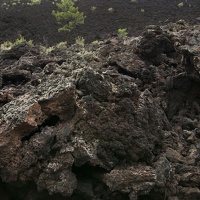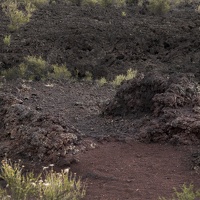Taking Root
 When the lava flowed and the cinder cone formed, all plant life within a several mile radius was destroyed. The oldest ponderosa pine trees here today are about 400 years old and are probably not the first generation to return. Unlike Hawaii where abundant moisture promotes plant growth soon after eruptions, precipitation here averages only 16 inches (41 cm) a year. Furthermore, soil is sparse in this dry climate where water limits plant life and organic material breaks down slowly.
When the lava flowed and the cinder cone formed, all plant life within a several mile radius was destroyed. The oldest ponderosa pine trees here today are about 400 years old and are probably not the first generation to return. Unlike Hawaii where abundant moisture promotes plant growth soon after eruptions, precipitation here averages only 16 inches (41 cm) a year. Furthermore, soil is sparse in this dry climate where water limits plant life and organic material breaks down slowly.
Notice the massive trailing root system of this dead tree. Trees growing on these cinder slopes face extraordinary challenges in finding anchor in loose, unstable cinders and in capturing water as it drains rapidly through them. Notice also how this tree spiraled as it grew. Ponderosa pines grow either straight or dextrally (spiraling to the right). Spiral growth reduces the overall strength of a tree but increases its flexibility. The spiral grain also provides an even distribution of water from a single root to all of the needles and of nutrients from a single branch to all the roots. In a straight tree, wind-damaged branches or damaged roots would deprive water and nutrients to the roots directly below and branches directly above. By spiraling, this tree was better adapted to the stresses of its environment: lack of water, high winds, and occasional heavy snow. But it wasn't able to remain anchored when its roots were exposed by erosion from foot traffic.
- Author
- Jamie Frees, Northern Arizona University Anthropology Laboratories
- File
- DSC_0829.jpg
- File size
- 2055 KB

